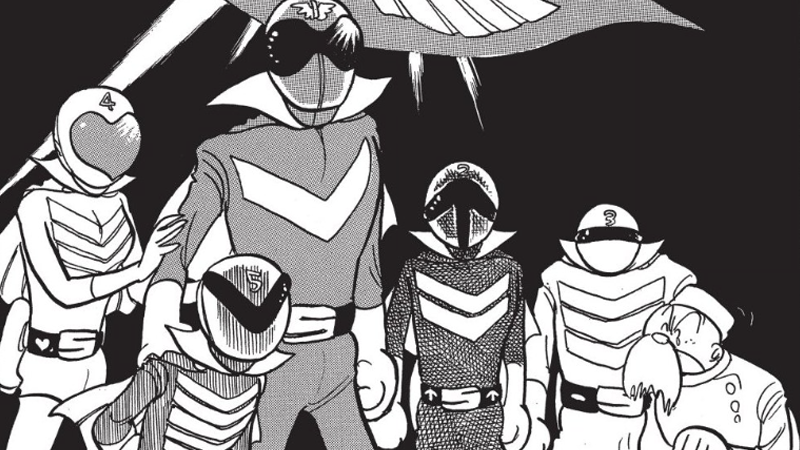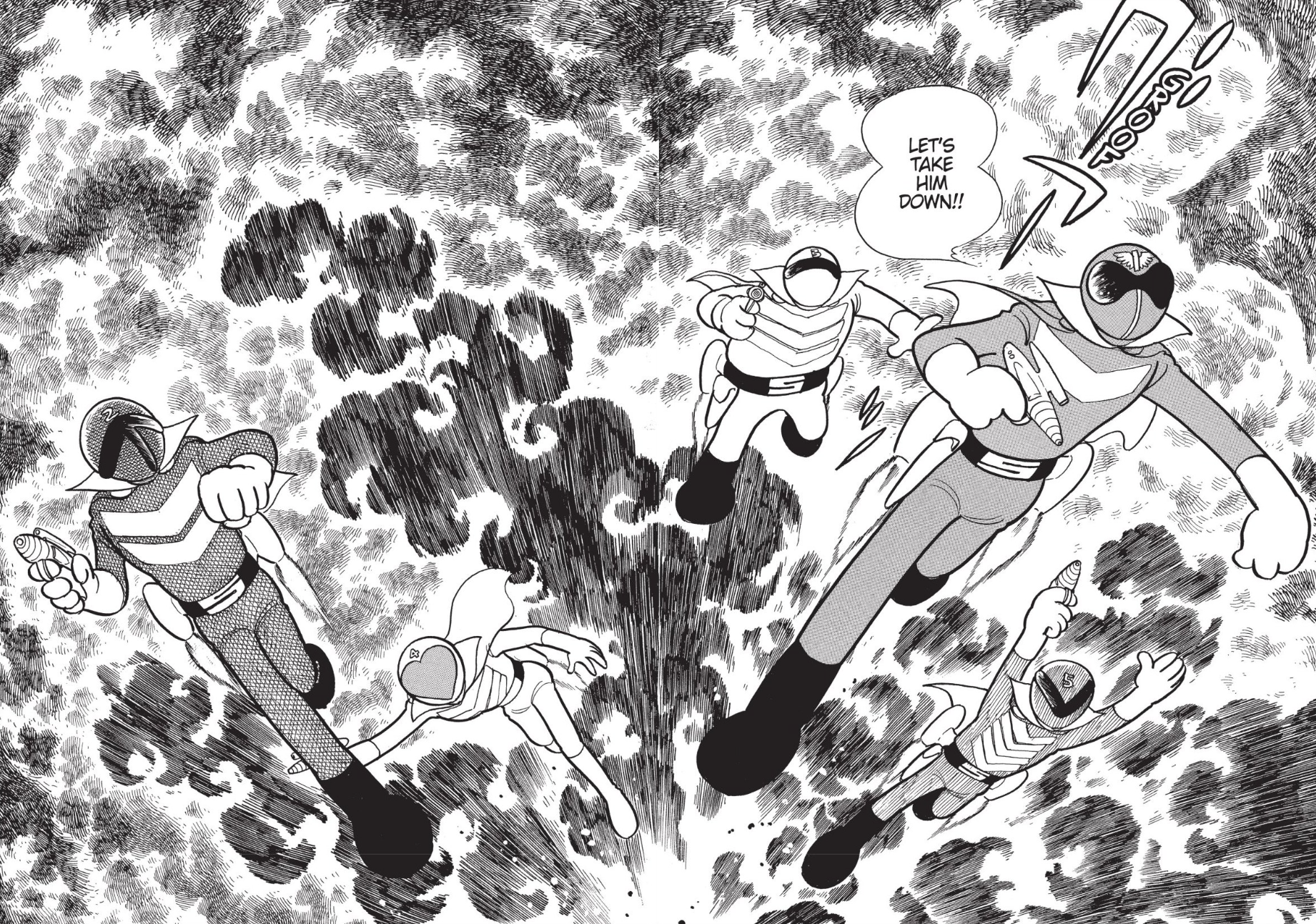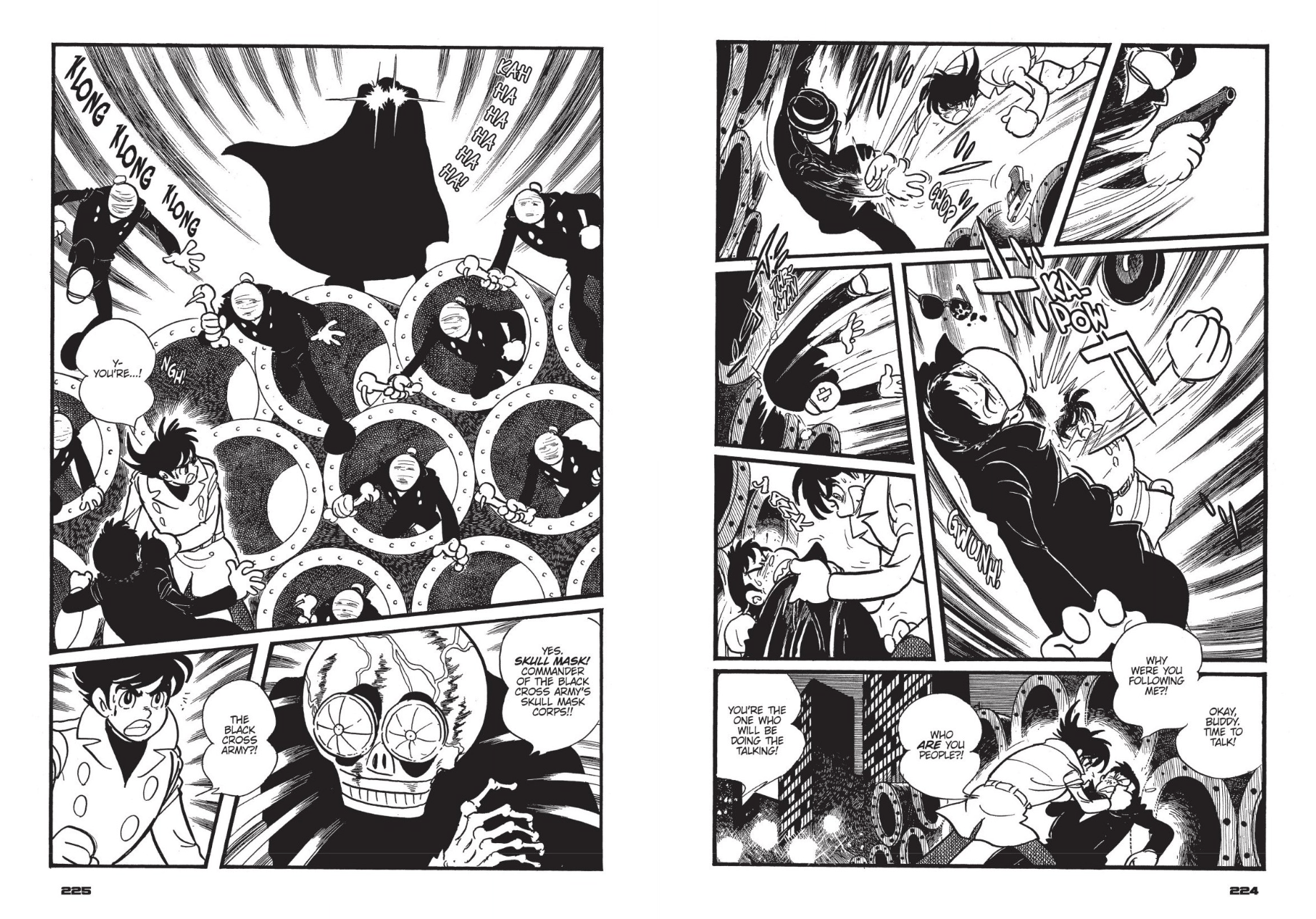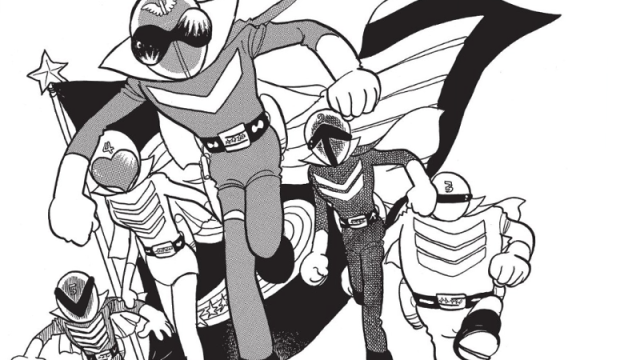Shotaro Ishinomori is one of the grandfathers of Tokusatsu as we know it — the legend behind Kamen Rider and Super Sentai. Without him, Japanese superheroes would be in a very different space today. But Ishinomori is equally remembered as a mangaka king: and when he combined the two, there were some truly remarkable results.
Before he became an icon of live-action superheroics, Ishinomori was known for his career as a mangaka; an assistant and student of Astro Boy icon Osamu Tezuka, his mentor’s style and kinetic artwork is keenly felt through Ishinomori’s superheroic work, from his early days illustrating and writing Cyborg 009 to his adaptive work bringing series like Kamen Rider, Himitsu Sentai Gorenger, Kikaider and more to the page after forging their legacies on the small screen. But what’s fascinating about revisiting Ishinomori’s Gorenger manga — written to tie in with the launch of the 1975 series but published last month in English for the first time by Seven Seas — is to not just see Ishinimori translate his work from one medium to another, but to do so twice, in very intriguingly different tones.

The new collection, translated by Alethea and Athena Nibley, covers two different serialisations Ishinomori wrote and illustrated over the summer of Himitsu Sentai Gorenger’s debut in 1975. The first, began in April, in the pages of Shōgaku Gonensei, an originally educational-focused magazine published by Shogakukan that targeted fifth-graders. The second began just a month after and ran in the pages of Weekly Shōnen Sunday, the still-running premiere manga magazine still published by Shogakukan — home to the likes of Inuyasha and Detective Conan over the years — aimed at young boys, from early teens to young adults. The new collection covers the Shōnen Sunday serialization first, creating an interesting parallel: the Shōnen Sunday manga for Gorenger was a loose serialisation of the show itself, which means that what you’re essentially getting is a Tokusatsu show in comic form.
Following five agents of the Kanto Japanese branch of EAGLE, Himitsu Sentai Gorenger (literally Secret Squadron Fiveranger) sees the titular group battle the Black Cross Army, a group of international thieves and intelligence operatives that steal top-secret technology and research to sell to the highest bidder, attempting to destablize the geopolitical landscape. Wearing specially designed suits that enhance their senses, power, and abilities, the Gorengers — Tsuyoshi Kaijo, Akarenger, Akira Shinmei, Aorenger, Daita Oiwa, Kirenger, Peggy Matsuyama, Momorenger, and Kenji Asuka, Midorenger — stage a secret war with the forces of the Black Cross, using their superpowers to overcome the sinister agency’s elite lieutenants, monstrous enhanced masked villains.

And that, really, is how the Shōnen Sunday serialisation reads — it’s a pulpy superhero classic, where our heroes overcome massive forces, from armies of tanks to giant mechanoid dragons, flying through the air on their miniaturised jetpacks or performing feats of heightened acrobatic dexterity and super strength. Ishinomori’s art is bold and striking, full of gorgeously fluid and bendy action panels as the Gorenger leap into explosive action. The plots are simple, bold, and relatively bloodless. Although there are a few broad strokes of emotional depth — the second story adopts a plotline where Akira is betrayed by his turncoat best friend, and ultimately forced to shoot him dead in a showdown — it’s mostly a celebration of what Tokusatsu does best. It’s a celebration presented in such a way that it doesn’t really need to rely on the threadbare budget of contemporary superhero TV like its live-action counterpart. Wild destruction, wilder explosions, grand setpieces, and intense action, it’s biff-baff-pow evocative of the bronze-age comics that were its contemporaries in the west. Think Batman, but with more primary colours.
The Shōgaku Gonensei serials, meanwhile, are much more grounded in tone (even if they do still deal with things like a purportedly psychic child, or advanced robots being stolen to sell on the black market), and emphasise the Gorenger less as superheroes and more as James Bond-ian superspies. There’s an emphasis on investigation before conflict, and the dazzling costumes — robbed of the bright technicolor seen on TV that created a franchise staple that still exists to this day — are almost perfunctory, with our heroes out of them more often than not. The secret aspect of the Gorengers is the primary focus here, as they skulk in shadows, infiltrate and engage in spycraft, and play shadow games with Black Cross’ similarly skulking agents.

It’s a fascinating contrast, made moreso by the fact that each serial opens with a different spin on Gorenger’s first episode. Both focus on Tsuyoshi discovering EAGLE’s plight and his destiny, driven by his father’s choice, to become the Akarenger and leader of EAGLE’s last hope in the Gorengers but Shōnen Sunday adopts a more traditionally actiony, dramatic tone. Tsuyoshi directly inherits his super-suit from his father to stage a test of its abilities, whereas in the Shōgaku Gonensei version it’s retrieved in a moment of haste, the dying wish of his father after Black Cross agents systematically target and destroy each branch of EAGLE in Japan, leaving only the Gorengers as survivors. Although both version include the death of Tsuyoshi’s dad, the Shōgaku Gonensei version is particularly violent and disorienting, leaving the young boy thrust into the world of enhanced spies, confused and angry morseo than he is nobly-vengeful in the other. The latter reads almost like a noir piece, Tsuyoshi being tailed in the dark rain by his would-be killers, compared to the father-son heated arguments of the Shōnen Sunday take.
It’s particularly interesting to see this tale, rendered in such a way officially for the first time, as Sentai — now Super Sentai, having evolved into a much more explicitly superpowered franchise, of big team gimmicks and giant robots — celebrates its 45th anniversary with Kikai Sentai Zenkaiger. Both manga present as easy parallels and roots for what the franchise would become on screen — this heady mix of over-the-top action and compelling, grounded heroes, everyday human beings given power rather than cybernetic experiments or magical aliens. And yet from the get go Ishinomori showed a fascinating balance between the superheroic and the human, whether on screen or on the page, that would secure Sentai’s status in decades to come as one of Japan’s most iconic hero franchises.

Comments